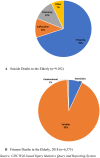Firearm Suicides in the Elderly: A Narrative Review and Call for Action
- PMID: 33547617
- PMCID: PMC7864138
- DOI: 10.1007/s10900-021-00964-7
Firearm Suicides in the Elderly: A Narrative Review and Call for Action
Abstract
Firearm suicides are one of the leading causes of death for older Americans. The purpose of this review is to explore the risk factors associated with suicides in the elderly, provide an overview of the epidemiology of firearm-related suicides in older Americans, and explore methods of preventing firearm suicides in the elderly. The vast majority (70 %) of elderly suicides in the U.S were committed using a firearm. Elderly firearm suicides have increased by 49 % between 2010 and 2018, disproportionately affecting white males. Yearly firearm suicides in the elderly ranged from 4,276 in 2010 to 6,375 in 2018. In 2018, the rate of elderly male firearm suicides was 24.96/100,000 compared to a rate of 1.92/100,000 for elderly females, a rate ratio of 13 to 1 for males compared to females. The primary risk factors for elderly firearm suicides seem to be physical illnesses, mental illnesses, and social factors. Older Americans engage in suicidal behaviors with greater planning and lethality of intent than do young adults. Of all the strategies to prevent suicides with firearms, the most efficacious measures based on current research seem to be state firearm legislation and improving mental healthcare, but these effects are not specific to the elderly. Strengthening state firearm laws and improving mental healthcare for the elderly may have promise in preventing elderly firearm-related suicides. Additional implications for practice and research are discussed in this review.
Keywords: Elderly; Firearms; Geriatrics; Injury; Mortality; Self-Harm; Suicide.
© 2021. The Author(s), under exclusive licence to Springer Science+Business Media, LLC part of Springer Nature.
Conflict of interest statement
Authors have no conflicts of interests to declare.
Figures
References
-
- Centers for Disease Control and Prevention. (2020). Fatal and non-fatal injury data. Web-based Injury Statistics Query and Reporting System (WISQARS). Retrieved November 27th, 2020, from https://www.cdc.gov/injury/wisqars/index.html.
-
- Price JH, Khubchandani J. Adolescent homicides, suicides, and the role of firearms: A narrative review. American Journal of Health Education. 2017;48(2):67–79. doi: 10.1080/19325037.2016.1272507. - DOI
Publication types
MeSH terms
LinkOut - more resources
Full Text Sources
Other Literature Sources
Medical
Miscellaneous


